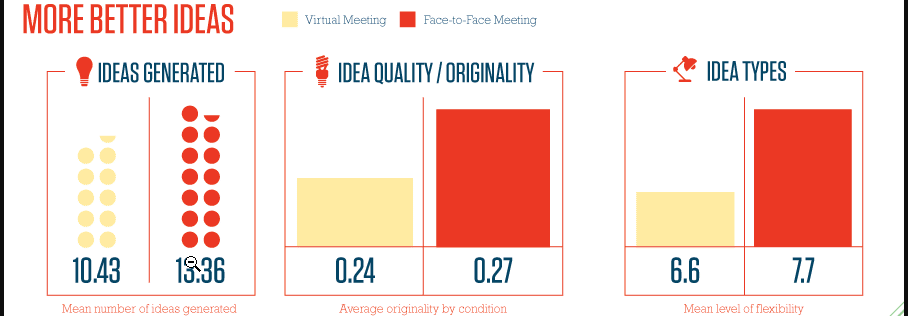You are 34X more likely to convert face to face than via email. Think about how much harder you have to work, even though email scales, you are still fighting many more forces working against you, like spam filters, the ease of saying “No” or “Unsubscribe” and so on.
You are 2X more likely to convert a prospect into a customer via a face to face meeting over a virtual meeting, according to Michael Massari, Senior Vice President of National Meetings and Events at Caesars Entertainment.
I love and appreciate virtual meetings and products like Zoom, but in terms of developing, nurturing and serving meaningful and trusting relationships, Zoom ain’t got nothing on face to face meetings.

Face to Face meetings tend to be more positive and perceived to be more convincing than virtual meetings. It’s not that they’re more convincing, it’s that you have a more receptive audience.
The parties involved in face to face meetings invest more to commit and attend and usually have more to lose (in terms of opportunity costs) of leaving a meeting early. There are significantly more logistical resources committed to a make a face to face meeting, so the parties are more likely to hear each other out, even when it’s a bad pitch. I know I’ve sat through some horrible meetings, just to avoid being perceived as rude, how about you?
So, face to face attendees are paying closer attention, and more likely to listen to understand, and consider whatever is being offered. Social norms make it rude to walk out, zone out, tune out, or otherwise distract yourself in a face to face meeting.
“Organizations depend on face-to-face meetings to win new customers, close new deals and develop high-performing talent. For example: You are twice as likely to convert prospects into customers with an in-person meeting. The likelihood of getting a “yes” increases, because it is so much easier to say “no” in an email or on a phone call.”
–Michael Massari, Senior Vice President of National Meetings and Events at Caesars Entertainment.

People Now More Than Ever Want Meaningful Connection And Relationships Of Substance And Depth
At a time when feelings of healthy social connections are at an all-time low, people desire the real deal. This desire, this increased demand, influences the outcomes of face to face meetings at all. People get more from them and give more to them in reciprocation.
Face to Face meetings give attendees:
- The ability to build stronger, more meaningful relationships
- The ability to read body language and other nonverbal communications, and indeed the energy or vibe of the interactions (literally chemicals we sense (source) and indeed energy field we observe (source)). There is more to the interaction than what meets the eye and is conveyed via video.
- Better environment for tough, timely decision making – The technical hurdles, bugs, and kinks that play out in the virtual realm really slow things down, and hinder the exchange. And when time or quality of the ideas count, these hiccups can be lethal for business. In face to face meetings, when the tech fails, someone whips out a flipchart, white board, or post-it notes, and you improvise and go to work.
This plays out in terms of the quality of resulting relationship as a result of the face to face meetings, the quality and quantity of new ideas generated.

Low and behold, face to face meetings lead to MORE and BETTER IDEAS. These ideas tend to be more original and flexible.
There’s more to it than all this – your verbal and nonverbal communication changes in virtual meetings.
The very thing that makes virtual meetings convenient, is also what hinders the ability to develop trust, and build meaningful relationships; they’re just to easy and convenient to do, and just as easy to leave, fake a technical-issue disconnect, or just tune out.
We evolved socially to interact in the same physical space.

The perception or threat of physical violence, loss of support and resources, or being kicked out of the community were strong incentives to build trusting relationships and honor them. Manners, hierarchies, religion, rituals, agreements, relationships, and trust-building were necessary to survival. We had to find ways of building social agreements in order to survive.
Integrity is still built in physical reality. By removing the physical plane, there is no primal need for social integrity – hence why people catfish and lie about themselves on dating apps, or about their business, or attentiveness to virtual meetings.
But not me, I’m a Level 7 Laser Lotus, super-evolved person… or am I?
It’s true that virtual meetings are certainly better than nothing, and will due in a pinch or pandemic, the performance hit of the current technology is important to factor into the architecture of the business.
Here are some more stats:
- In-person requests are 34 times more successful than those made over email (source).
- The close rate for in-person meetings is 40% (source).
- Executives and business travelers estimate that 28% of their current business would be lost without in-person meetings (source).
- For every $1 spent on investment travel – the average ROI is $12.50 (source).
Okay, so virtual meetings are second fiddle to face to face for new relationships and negotiations, but what about dealing with remote teams?
Virtual Meeting Attendees Are More Likely To Be Treated Like Holograms On Star Trek

Human beings are more likely to treat virtual meeting attendees like holograms on Star Trek; we are prone to being dismissive, inconsiderate and neglectful. Why? Because our brain recognizes the difference between a real live person and abstraction, a cartoon, or hologram. And because at a primal level, we know we are not in danger of one party throat punching the other. This is the same unconscious brain behavior that drives millions of people to lie about themselves online, in dating apps and elsewhere on the web. Virtual meetings are no different.
This means that virtual meetings are less engaging than face to face meetings. Yes – and this is partly why physical experiences and events were on the rise before the Chinese Coronavirus Pandemic.
Working with remote teams, this encourages more passive-aggressive feet dragging, undermining behavior, as there is no perceived primal threat in the immediate environment.
I’ve worked with distributed teams and remote workers for 17 years, and you can tell based on the non-verbal communication in the meetings, and resulting work performance, who totally blew you off in the meeting, who doesn’t agree with you, and expresses it via feet dragging. Short of getting fired, which is less of a traumatic experience when it is remote (especially when it’s not in the same community), there are fewer effective repercussions.
If you were to ask my fellow millennials about wanting to work remotely, they are all for it, but they’re not coming from a place of driving higher performance for the business. Under the hood of that vote, is self-interest to streamline their work-flow, not necessarily output and contributions to the organization. Of course, they want it, it’s only human. The distance reduces repercussions, accountability, oversight and enables more anti-social, passive-aggressive retaliatory behavior – AKA the dark side of the introvert’s playbook. I know that’s a huge call out but it’s important. Not everything new is better. It’s important to be discerning with what you’re trying to achieve, and how you measure it.
Bottom Line
So, just like the rest of the social interactions on the Internet, virtual meetings are less likely to convert and enable bad behavior. And it’s important to factor these things into your cost/benefit analysis of how you use these tools. Does bad behavior happen all the time? Does it always lead to an insurrection No.
However, if you care about work performance and growth, and geek out about it the way I do, it’s important to understand all the contributing elements and how they help or hinder your growth and performance. The insight is, we need more effective incentives to drive integrity and trust-building on the web. Virtual meetings in their current form (video conference), just doesn’t cut it. Internally, distributed workforces need to do more to establish a meaningful connection to the business and chain of command.
Parties in virtual meetings are more likely to be skeptical, reluctant, less attentive, and less considerate of the deal being pitched. There’s a 2X force multiplier at play, so when it comes to developing new business or negotiating, is this edge worthy of moving the meeting face to face? For me it’s a resounding yes.
Here's an AWESOME INFOGRAPHIC FOR FACE TO FACE MEETINGS (click to expand)

Special Sauces (slang for sources -TMYK)
Sources – Additional Information
https://blog.zoominfo.com/face-to-face-sales-meetings/
https://hbr.org/2017/04/a-face-to-face-request-is-34-times-more-successful-than-an-email
https://greatbusinessschools.org/networking/
https://www.neurologytimes.com/blogs/how-real-are-vibes-good-and-bad
https://explore.scimednet.org/index.php/2016/04/02/the-human-energy-field/





0 Comments